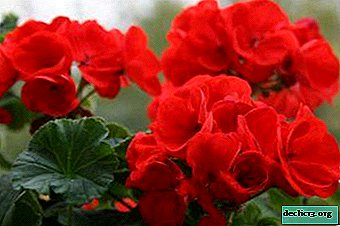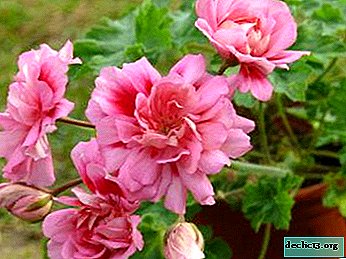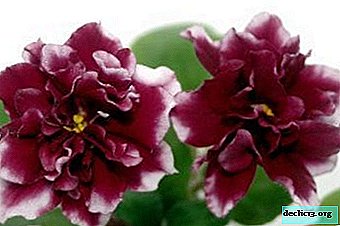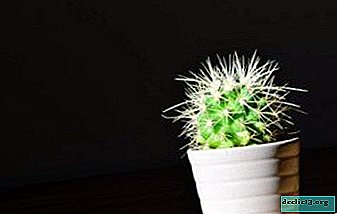Cause the delight and admiration of the neighbors: how to cut geranium so that it is fluffy?

Bright, lush and fragrant inflorescences of geraniums cause delight and admiration. Each grower dreams of transforming his flower so that it could not be passed by without casting a gaze.
In order for geranium to please household members with lush buds of inflorescences, it is necessary to properly monitor it and timely pinch and trim. The correctness of this procedure will be discussed in our article.
Beauty and a riot of colors!
Pelargonium (popularly called geranium) got its name due to the extraordinary shape of the fruit, which resembles a beak of a crane. From Greek, "geranios" is translated as "crane". To date, over four hundred varieties of geraniums are known, but only about a hundred species grow and are safely grown in Russia.
ATTENTION: Geranium is divided into two large subspecies - indoor (pelargonium) and garden. Indoor types of geraniums are very sensitive to temperature extremes and weather conditions, so when planting in the garden they can die.On the windowsills of houses and offices you can find the most diverse types of room geranium, which differ from each other in the shape and size of leaves, inflorescences and color. Among the many species, there are six of the most popular:
 Angel - gives a pleasant aroma and pleases with a long flowering period.
Angel - gives a pleasant aroma and pleases with a long flowering period.- Ampelskaya - It is distinguished by the presence of long branches, so it is more suitable for landing in hanging planters.
- Royal (royal, Martha Washington, noble, homely) - characterized by the presence of a dark spot located on each petal of a large flower.
- Fragrant - possesses persistent aroma. Different varieties have different aromas - rose, wormwood, lemon, vanilla.
- Zonal - flowers have a double color with a sharp and clear transition.
- Gorgeous (blood red, garden) - Suitable not only for planting at home, but also in the garden. It has a strong root system.
With proper and constant care, geranium will bloom constantly and violently, each year increasing the number of inflorescences. But what is meant by proper care?
Why is a plant shape corrected?
No matter what flower you are dealing with - indoor or garden - pruning geraniums is necessary from the very beginning of its landing. Depending on the species, the branches of the plant can be long - lodging or erect, as well as short and sloppy.
To give the flower the desired shape, you need to systematically monitor the newly emerging shoots and trim in time.
Despite the fact that geranium is very unpretentious, it is not able to independently produce lateral shoots, although there are plenty of sleeping buds on them - they are located in each node.
Trimming contributes not only to the formation of a beautiful shape, but also activates the growth of new side shoots and contributes to the emergence of new bud inflorescences. Thus, the plant will gain strength and every year its flowering will be more magnificent and long.
IMPORTANT: If you do not prune the geranium, then the plant will soon become shapeless, and the number of inflorescences will gradually decrease. Long stems eventually drop the lower leaves, and as a result, the flower looks very sparse - curved bare stems with a few leaves on the crown.Such a plant will not give good planting material for propagation and may soon die. Therefore, pruning at home is one of the basic rules for the care of geraniums.
Read about how to care for geraniums at home here, and from this article you will learn about recommendations for caring for plants in open ground.
How to prune geraniums: step by step instructions?
 No unique tools needed to cut geraniums. You will need a clerical knife (it can be replaced with a blade or even a thin kitchen knife).
No unique tools needed to cut geraniums. You will need a clerical knife (it can be replaced with a blade or even a thin kitchen knife).
Scissors and secateurs are not suitable for this procedure, as they squeeze the stem of the plant at the place of cut. Before cutting, the tool should be treated with a disinfectant solution so as not to introduce the infection into a fresh wound.
As such a solution, ordinary ethyl alcohol can serve. Alternatively, you can boil the instrument for several minutes.
Geranium pruning should be done on time - not too often, but not at large time intervals, and at suitable times of the year. It is impossible to prune a lot of shoots at a time, or to carry out this procedure in the winter, but is it possible to prune geraniums in the summer? Geranium is pruned in spring and autumn. But here there are differences, which must be remembered when planning to ennoble the plant.
Watch the video about the correct pruning of room geranium (pelargonium):
Giving the desired shape in the spring
Before proceeding with the procedure for pinching geraniums, you should carefully inspect it and carefully consider the desired shape of the flower. Having prepared the tools and processed them, you can safely get to work.
- Remove yellowed and dry leaves manually, carefully cut weak and injured branches.
- Gradually cut the side stems, leaving the strongest and strongest.
- Remove lateral shoots from the remaining stem.
- If the stem is too tall, it is necessary to carefully remove part of the apex.
- If the stems are curved and have a large length, they need to be cut, leaving only 10 cm. After a few weeks, young leaves will appear in place of these stumps.
- When preserving a kidney on adjacent stems, it is important to pay attention to the direction of its growth - it should be opposite to the main stalk.
- Apply disinfectants to the cut points - wood ash, ground cinnamon, crushed activated carbon.
After pruning the geranium in the spring, it will give new inflorescences a few months later than when this procedure was brought up in the fall, since the plant will restore strength longer. If necessary, pinch in the spring months, you can remove up to 20% of the shoots so that it is lush. Abundant pruning may affect the timing of the next flowering of geraniums.by sliding it until next season.
Autumn pinch
 Autumn nipping is the best option, as the plant will need less time to recover. Slices are carried out with a sharp disinfected knife at an angle of 45-60 degrees directly in 5 mm above the sheet node.
Autumn nipping is the best option, as the plant will need less time to recover. Slices are carried out with a sharp disinfected knife at an angle of 45-60 degrees directly in 5 mm above the sheet node.
Only those nodes that have a growth direction opposite to the main stem need to be trimmed. New shoots from such buds will not grow upward, but will be directed to the sides, which will prevent thickening of the crown.
Before starting work, you need to prepare the tools and carefully examine the flower, having studied its shape and the location of the stems.
- All cuts are made only over the leaf node. Shoots growing inside the bush, crossing or dried up are immediately removed.
- First of all, the outer stems are cut so that you can get to the center. If you need to cut a lot of stems, it is better to carry out this procedure in several passes with an interval of 2-3 weeks. So the plant can each time restore power before a new pinch.
- To form new peduncles, it is necessary to trim the ends of the stems, leaving 4-5 leaf nodes.
- Apply ash, crushed activated carbon or crushed cinnamon to fresh wounds - they have a disinfecting property.
- To support the flower, add fertilizers with nitrogen content to the soil (about what the composition of the soil should be for room geraniums, whether universal soil is suitable, read here). Provide enough light and heat for the upcoming wintering (how to care for home geraniums in order to preserve it in winter and whether it is possible to transfer a garden flower to the basement can be found here).
Such pruning procedures are carried out in order to make the plant feel comfortable, always glad the hosts with greenery and bright colors. If the purpose of pruning was the formation of a certain shape of the crown, it is important to consider several features.
Watch the video about the autumn pinch of geranium (pelargonium):
How to achieve lush flowering?
The frequency and duration of flowering of domestic geraniums depends on its type, on the conditions in which it grows, and, of course, when pruning is done. To make it fluffy, cut geraniums in autumn.
If the stems are stretched too much during the winter, do not touch them. In late February, you can shorten them by only 2/3 of the total length, and in the spring to make a pinch.
 If we are talking about a large and dense plant, then you can not cut a lot of stems at once, since all the forces of the flower will go to restore the stems and leaves. It is enough to shorten the stalks that have broken out so that the flower regains its beautiful shape.
If we are talking about a large and dense plant, then you can not cut a lot of stems at once, since all the forces of the flower will go to restore the stems and leaves. It is enough to shorten the stalks that have broken out so that the flower regains its beautiful shape.
A lush bush is obtained with constant care and systematic pinching. If you need to achieve lush leaves, you need to trim the outer stems under the stumps, leaving them small - 7-10 cm.
Then the flower will be able to give new inflorescences, and new young leaves will appear in place of the stumps. In the future, you just need to shorten the long stems just above the leaf nodule, from which young shoots and leaves will then go.
Shtambovy formation of a tree
First of all, you need to remove the side shoots, and the central stem in several places to fix to the vertical support.
You can trim the shoot only when it exceeds the height of the support. Due to the frequent pinching, the central trunk will branch, which will subsequently form a lush crown.
TIP: The shoots must be nipped after the formation of every fourth leaf. However, with this treatment, flowering can begin only after a year.Further care
After trimming, home care is necessary: fresh wounds of geraniums must be sprinkled with wood ash or activated charcoal. Minimum watering will be optimal, as the number of foliage has decreased significantly, which contributes to long-term evaporation.
It will not be superfluous to fertilize with nitrogen fertilizers, which will help recover from stress and stimulate the growth of new shoots (for more information on what to feed and when to use fertilizers, read here, and from this article you will learn how to use iodine with hydrogen peroxide for beautiful flowering). Each plant needs to be looked after.
Geranium, being unpretentious in terms of watering and climate, requires constant attention and systematic pruning. The shape of the bush, the duration and frequency of flowering directly depend on how frequent and competent pruning will be.

 Angel - gives a pleasant aroma and pleases with a long flowering period.
Angel - gives a pleasant aroma and pleases with a long flowering period.















